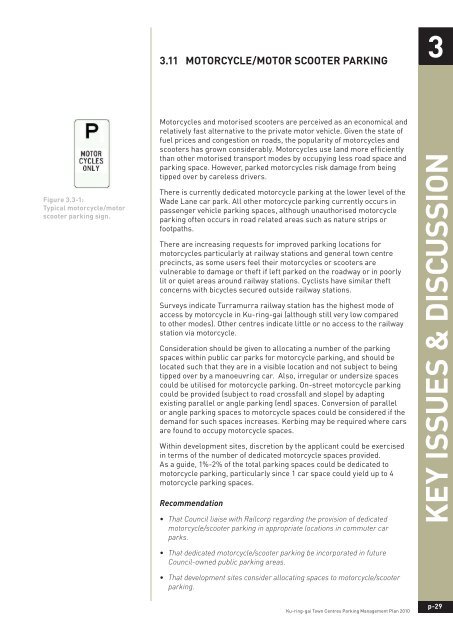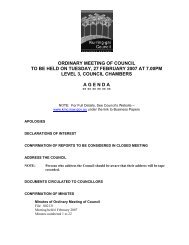pdf. 4MB - Ku-ring-gai Council
pdf. 4MB - Ku-ring-gai Council
pdf. 4MB - Ku-ring-gai Council
You also want an ePaper? Increase the reach of your titles
YUMPU automatically turns print PDFs into web optimized ePapers that Google loves.
3.11 MOTORCYCLE/MOTOR SCOOTER PARKING<br />
3<br />
Figure 3.3-1:<br />
Typical motorcycle/motor<br />
scooter parking sign.<br />
Motorcycles and motorised scooters are perceived as an economical and<br />
relatively fast alternative to the private motor vehicle. Given the state of<br />
fuel prices and congestion on roads, the popularity of motorcycles and<br />
scooters has grown considerably. Motorcycles use land more efficiently<br />
than other motorised transport modes by occupying less road space and<br />
parking space. However, parked motorcycles risk damage from being<br />
tipped over by careless drivers.<br />
There is currently dedicated motorcycle parking at the lower level of the<br />
Wade Lane car park. All other motorcycle parking currently occurs in<br />
passenger vehicle parking spaces, although unauthorised motorcycle<br />
parking often occurs in road related areas such as nature strips or<br />
footpaths.<br />
There are increasing requests for improved parking locations for<br />
motorcycles particularly at railway stations and general town centre<br />
precincts, as some users feel their motorcycles or scooters are<br />
vulnerable to damage or theft if left parked on the roadway or in poorly<br />
lit or quiet areas around railway stations. Cyclists have similar theft<br />
concerns with bicycles secured outside railway stations.<br />
Surveys indicate Turramurra railway station has the highest mode of<br />
access by motorcycle in <strong>Ku</strong>-<strong>ring</strong>-<strong>gai</strong> (although still very low compared<br />
to other modes). Other centres indicate little or no access to the railway<br />
station via motorcycle.<br />
Consideration should be given to allocating a number of the parking<br />
spaces within public car parks for motorcycle parking, and should be<br />
located such that they are in a visible location and not subject to being<br />
tipped over by a manoeuv<strong>ring</strong> car. Also, irregular or undersize spaces<br />
could be utilised for motorcycle parking. On-street motorcycle parking<br />
could be provided (subject to road crossfall and slope) by adapting<br />
existing parallel or angle parking (end) spaces. Conversion of parallel<br />
or angle parking spaces to motorcycle spaces could be considered if the<br />
demand for such spaces increases. Kerbing may be required where cars<br />
are found to occupy motorcycle spaces.<br />
Within development sites, discretion by the applicant could be exercised<br />
in terms of the number of dedicated motorcycle spaces provided.<br />
As a guide, 1%-2% of the total parking spaces could be dedicated to<br />
motorcycle parking, particularly since 1 car space could yield up to 4<br />
motorcycle parking spaces.<br />
Recommendation<br />
• That <strong>Council</strong> liaise with Railcorp regarding the provision of dedicated<br />
motorcycle/scooter parking in appropriate locations in commuter car<br />
parks.<br />
KEY ISSUES & DISCUSSION<br />
• That dedicated motorcycle/scooter parking be incorporated in future<br />
<strong>Council</strong>-owned public parking areas.<br />
• That development sites consider allocating spaces to motorcycle/scooter<br />
parking.<br />
<strong>Ku</strong>-<strong>ring</strong>-<strong>gai</strong> Town Centres Parking Management Plan 2010<br />
p-29

















